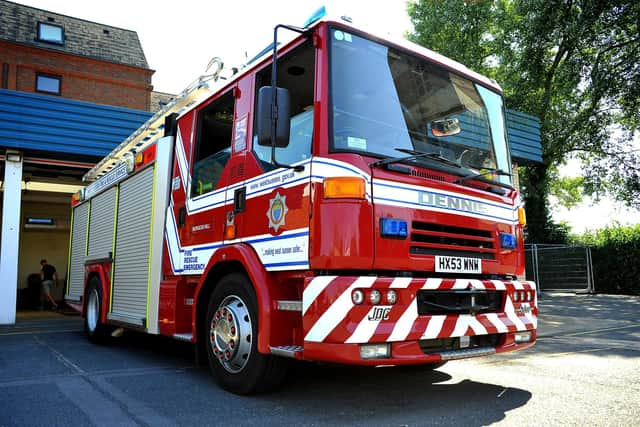Here's what latest inspection said about West Sussex Fire and Rescue Service
and live on Freeview channel 276
The service was rated ‘requires improvement’ for efficiency and effectiveness following an inspection in 2018, and ‘inadequate’ for the way it looked after its people.
Almost four years later and seven of the 11 categories in the inspection have improved – with no ‘inadequates’ in sight.
Advertisement
Hide AdAdvertisement
Hide AdUnfortunately, one of the issues still lingering is that of bullying, harassment and discrimination – something Chief Fire Officer Sabrina Cohen-Hatton acknowledged would take more than a couple of years to put right.


In his report following the latest inspection, which was published on Wednesday (July 27), Her Majesty’s Inspector Matt Parr said “The service has made significant progress in many areas since our last inspection.
“It must now maintain and build on this improvement, making it a priority to continue to tackle bullying, harassment and discrimination.
“This should include making sure that all staff understand and act on the service’s values.”
Advertisement
Hide AdAdvertisement
Hide AdThe service has been told to submit an updated action plan by August 31 showing how it will work with staff in that area.


Dr Cohen-Hatton said one incident going unchallenged was ‘one too many’, adding that while the problem used to be widespread, it was now ‘more isolated’.
She said: “The inspectorate has reported that they have seen an increase in the number of disciplinary cases – we’re taking it seriously.
“We mean it when we say there’s a zero tolerance approach.
“There have been dismissals at various levels throughout the service as a result.
Advertisement
Hide AdAdvertisement
Hide Ad“There is work going on. I am saddened to see it there but equally we knew that this one would take longer.”
Staff have certainly reported problems more often – 13 grievances were raised in 2020/21, compared to four the previous year.
But the inspector’s report said that 112 of the 217 staff who took part in a survey felt unable to challenge unacceptable behaviour ‘without worrying about how they would be treated afterwards’.
The inspector highlighted a number of key areas in which West Sussex had made progress.
They included:
Advertisement
Hide AdAdvertisement
Hide AdImproved response to incidents, with the service commanding them well and engines arriving within expected time frames Improvements to staff management and training – having the right people with the right skills Improved efficiency such as making made comprehensive plans for carrying out its work in different future financial situations.
Dr Cohen-Hatton acknowledged that service-wide improvement was not going to be a quick fix – but the signs of progress were certainly there.
She pointed out that at the time of the 2018 inspection, West Sussex was the second poorest performing service in the country – possibly the poorest in some areas.
Now it is comfortably in the middle of the pack but much, much higher when it comes to efficiency.
Advertisement
Hide AdAdvertisement
Hide AdShe added: “We had a lot of investment from the council which we really needed to be able to deliver this.
“Not only have we made improvements but we’ve done it efficiently.
“We’ve spent the public pound well and thoughtfully and delivered results.”
It’s important to remember that more than two years of the service’s work to improve has been hampered by the pandemic and all the personal and professional hurdles it placed in front of staff.
Advertisement
Hide AdAdvertisement
Hide AdDr Cohen-Hatton said: “Despite that they believed in the service so much that not only did they come into work and completely pivot and change the way we did our normal business, but they carried on with what they believed in and needed to do to make the changes that we’ve seen reflected in our judgement.
“I’m so proud of them for that.”
When it came to the day-to-day work of the service, one problem remained frustratingly high – the number of false alarms.
Of the 8.797 incidents crews attended in the year to the end of June 2021, 4,292 were false alarms – that’s just shy of 50 per cent.
Another issue marked as needing improvement was the availability of on-call fire engines.
Advertisement
Hide AdAdvertisement
Hide AdWest Sussex set itself a target of 75 per cent but only achieved 69.1 per cent.
Dr Cohen-Hatton said this was a problem faced by all fire services which had retained firefighters.
Her team has been engaged in a national working group looking at systemic changes and improvements – but she said the county ‘can’t wait for national solutions to problems that are affecting us here’.
As such. the issue was flagged as a priority in the community risk management plan 2022–2026.
Advertisement
Hide AdAdvertisement
Hide AdWork will involve looking at more flexible contracts for the retained crews and easing some of the restraints put around the system.
Dr Cohen-Hatton said she made no apology for setting a ‘challenging target’.
She added that the services failed to meet its targets for response times for five years in a row but had now achieved it for the last two years.
The average response time was 9 minutes 33 seconds across the county.
Advertisement
Hide AdAdvertisement
Hide AdShe said: “Despite the fact we’ve got a bit more work to do on our availability – and we will continue to do that – residents in West Sussex will still get a fire engine quickly when they pick up the phone and dial 999.”
It’s been ten months since the service was inspected and Dr Cohen-Hatton said she was confident that things have moved on and improved since then.
She said: “I’m quite looking forward to the next time they come in actually, because we’ll really be able to show some of that progress we’ve been able to make since the restrictions of the pandemic have eased and we’ve been able to get back in the saddle and drive some of those activities forward.”
While she had no idea when the next inspection would be, her message was clear – “Bring it on!”